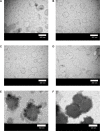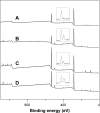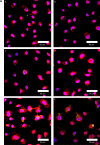Rescuing apoptotic neurons in Alzheimer's disease using wheat germ agglutinin-conjugated and cardiolipin-conjugated liposomes with encapsulated nerve growth factor and curcumin
- PMID: 25878499
- PMCID: PMC4388084
- DOI: 10.2147/IJN.S79528
Rescuing apoptotic neurons in Alzheimer's disease using wheat germ agglutinin-conjugated and cardiolipin-conjugated liposomes with encapsulated nerve growth factor and curcumin
Abstract
Liposomes with cardiolipin (CL) and wheat germ agglutinin (WGA) were developed to permeate the blood-brain barrier and treat Alzheimer's disease. WGA-conjugated and CL-incorporated liposomes (WGA-CL-liposomes) were used to transport nerve growth factor (NGF) and curcumin (CUR) across a monolayer of human brain-microvascular endothelial cells regulated by human astrocytes and to protect SK-N-MC cells against apoptosis induced by β-amyloid1-42 (Aβ(1-42)) fibrils. An increase in the CL mole percentage in lipids increased the liposomal diameter, absolute zeta potential value, entrapment efficiency of NGF and CUR, release of NGF, biocompatibility, and viability of SK-N-MC cells with Aβ(1-42), but decreased the atomic ratio of nitrogen to phosphorus and release of CUR. In addition, an increase in the WGA concentration for grafting enhanced the liposomal diameter, atomic ratio of nitrogen to phosphorus, and permeability of NGF and CUR across the blood-brain barrier, but reduced the absolute zeta potential value and biocompatibility. WGA-CL-liposomes carrying NGF and CUR could be promising colloidal delivery carriers for future clinical application in targeting the blood-brain barrier and inhibiting neurotoxicity.
Keywords: Alzheimer’s disease; cardiolipin; curcumin; liposome; nerve growth factor; wheat germ agglutinin.
Figures













Similar articles
-
Wheat germ agglutinin-conjugated liposomes incorporated with cardiolipin to improve neuronal survival in Alzheimer's disease treatment.Int J Nanomedicine. 2017 Mar 2;12:1757-1774. doi: 10.2147/IJN.S128396. eCollection 2017. Int J Nanomedicine. 2017. PMID: 28280340 Free PMC article.
-
Optimized liposomes with transactivator of transcription peptide and anti-apoptotic drugs to target hippocampal neurons and prevent tau-hyperphosphorylated neurodegeneration.Acta Biomater. 2019 Mar 15;87:207-222. doi: 10.1016/j.actbio.2019.01.065. Epub 2019 Feb 1. Acta Biomater. 2019. PMID: 30716553
-
Cardiolipin-incorporated liposomes with surface CRM197 for enhancing neuronal survival against neurotoxicity.Int J Pharm. 2014 Oct 1;473(1-2):334-44. doi: 10.1016/j.ijpharm.2014.07.003. Epub 2014 Jul 4. Int J Pharm. 2014. PMID: 24999054
-
Application of curcumin nanoformulations in Alzheimer's disease: prevention, diagnosis and treatment.Nutr Neurosci. 2023 Aug;26(8):727-742. doi: 10.1080/1028415X.2022.2084550. Epub 2022 Jun 11. Nutr Neurosci. 2023. PMID: 35694842 Review.
-
Action Mechanisms of Curcumin in Alzheimer's Disease and Its Brain Targeted Delivery.Materials (Basel). 2021 Jun 16;14(12):3332. doi: 10.3390/ma14123332. Materials (Basel). 2021. PMID: 34208692 Free PMC article. Review.
Cited by
-
Nerve Growth Factor Protects Against Pyrethroid-Induced Endoplasmic Reticulum (ER) Stress in Primary Hippocampal Neurons.Toxicol Sci. 2020 Mar 1;174(1):147-158. doi: 10.1093/toxsci/kfz239. Toxicol Sci. 2020. PMID: 31841155 Free PMC article.
-
Use of curcumin in diagnosis, prevention, and treatment of Alzheimer's disease.Neural Regen Res. 2018 Apr;13(4):742-752. doi: 10.4103/1673-5374.230303. Neural Regen Res. 2018. PMID: 29722330 Free PMC article. Review.
-
Conjugation, Prodrug, and Co-Administration Strategies in Support of Nanotechnologies to Improve the Therapeutic Efficacy of Phytochemicals in the Central Nervous System.Pharmaceutics. 2023 May 23;15(6):1578. doi: 10.3390/pharmaceutics15061578. Pharmaceutics. 2023. PMID: 37376027 Free PMC article. Review.
-
Effects of Micro-environmental pH of Liposome on Chemical Stability of Loaded Drug.Nanoscale Res Lett. 2017 Aug 23;12(1):504. doi: 10.1186/s11671-017-2256-9. Nanoscale Res Lett. 2017. PMID: 28836126 Free PMC article.
-
Broad-Spectrum Theranostics and Biomedical Application of Functionalized Nanomaterials.Polymers (Basel). 2022 Mar 17;14(6):1221. doi: 10.3390/polym14061221. Polymers (Basel). 2022. PMID: 35335551 Free PMC article. Review.
References
-
- Gaugler J, James B, Johnson T, Scholz K, Weuve J. 2014 Alzheimer’s disease facts and figures. Alzheimers Dement. 2014;10:1–75. - PubMed
-
- Citron M. Alzheimer’s disease: strategies for disease modification. Nat Rev Drug Discov. 2010;9:387–398. - PubMed
-
- Duyckaerts C, Delatour B, Potier MC. Classification and basic pathology of Alzheimer disease. Acta Neuropathol. 2009;118:5–36. - PubMed
-
- Turner PR, O’Connor K, Tate WP, Abraham WC. Roles of amyloid precursor protein and its fragments in regulating neural activity, plasticity and memory. Prog Neurobiol. 2003;70:1–32. - PubMed
-
- van Oijen M, Hofman A, Soares HD, Koudstaal PJ, Breteler MM. Plasma Aβ1–40 and Aβ1–42 and the risk of dementia: a prospective case-cohort study. Lancet Neurol. 2006;5:655–660. - PubMed
Publication types
MeSH terms
Substances
LinkOut - more resources
Full Text Sources
Other Literature Sources
Medical

